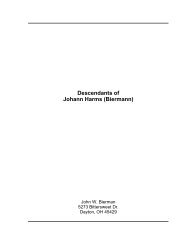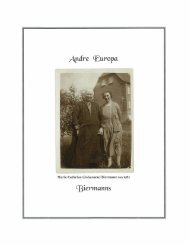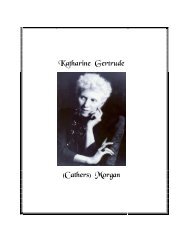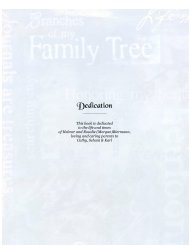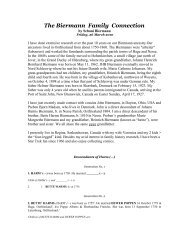A Collection of Dad's Essay's & Writings - Welcome
A Collection of Dad's Essay's & Writings - Welcome
A Collection of Dad's Essay's & Writings - Welcome
You also want an ePaper? Increase the reach of your titles
YUMPU automatically turns print PDFs into web optimized ePapers that Google loves.
Reginal Heber wrote the words to “Holy, Holy, Holy” which, from time to time, has been voted as one <strong>of</strong> the most<br />
popular hymns among members <strong>of</strong> various parishes and congregations. The hymn is generally used during Pentecost<br />
and is No. 165 in the Lutheran Book <strong>of</strong> Worship. Heber was born in England and at one point in his life he became a<br />
clergyman, journeyed to India where he became Bishop <strong>of</strong> Calcutta. He wrote a number <strong>of</strong> texts for use as hymns and<br />
also wrote a book on his adventures published under the title <strong>of</strong> “A Narrative <strong>of</strong> a Journey Through India” in 1828.<br />
Among his other writings were several poems and sermons. The music to “Holy, Holy, Holy” was composed by John<br />
Bacchus Dykes.<br />
The words <strong>of</strong> Jesus on the cross “Eli, eli, lama sabachthani” or “Eloi, Eloi”, which is in Hebrew and Aramaic,<br />
translates into “Why hast Thou Forsaken Me”. It is found in the Gospel <strong>of</strong> St. Matthew and the Gospel <strong>of</strong> St. Mark but<br />
also may be a quotation from the Psalm No. 22 which begins “My God, My God, why have you forsaken me and are<br />
so far from my cry and from the words <strong>of</strong> my distress.” There is also a Greek text which retains the original.<br />
In July, one <strong>of</strong> the lesser festivals and commemorations honors Vladimir, the first Christian ruler in Russia who<br />
was a grand duke <strong>of</strong> Kiev and united that part <strong>of</strong> the country. He married Princess Anna, sister <strong>of</strong> the Byzantine ruler<br />
and accepted Christianity in 988 or 989 and made Greek Orthodox the accepted religion and liturgy <strong>of</strong> his household.<br />
St. Vladimir then devoted the rest <strong>of</strong> his life to the building <strong>of</strong> churches. He also established schools and libraries and<br />
enacted several statutes concerning legality within the courts <strong>of</strong> the church. He was the grandson <strong>of</strong> St. Olga who<br />
accepted Christianity in 957. Vladimir died in July <strong>of</strong> 1015 and commemoration for both is July 15. Feast day for St.<br />
Olga is July 11.<br />
It is certainly true that the Lutheran hymnody was in many ways part <strong>of</strong> liturgical conservatism as well as an<br />
attempt to reach l<strong>of</strong>ty heights. Throughout the past five centuries, however, the hymnody has accumulated texts and<br />
music from many faiths and each hymn has either an interesting story or at least a reason for its creation. So many <strong>of</strong><br />
these are not known to parish members. It is interesting to note that when hymns were selected for parish use, each<br />
one was investigated for doctrinal purity and excellence <strong>of</strong> literary form. Excellence in musical content has graced<br />
many hymns. The music for hymn should be distinctive, reverent and <strong>of</strong> a high standard. The music for the Liturgy<br />
has always been <strong>of</strong> a high standard and should not infer any secular character but be devotional. It is only right that<br />
the hymnody should follow the same rules. Unfortunately, some hymns do not fit this high standard but are included<br />
because <strong>of</strong> popular demand. So at least the hymnody did become comprehensive.<br />
Often when members <strong>of</strong> a parish assemble for meeting and a meal, it is traditional to sing the Doxology<br />
before the meal is taken. “Praise God From Whom All Blessings Flow” can be attributed to an English prelate and<br />
hymn writer, Thomas Ken, who was appointed chaplain to King Charles II in 1680 after the Restoration had ended<br />
the disastrous Cromwellian intolerance. He was nominated by the monarch to the bishopric <strong>of</strong> Wells and Bath in<br />
1684. Ken was born in 1637 and died in 1711 during the reign <strong>of</strong> Queen Anne just prior to the Hanoverian accessions.<br />
The music is by Louis Bourgeois, a French Protestant musician who eventually went to Geneva to join the Calvinists.<br />
He contributed to the Genevan Psalter by picking out hymns and harmonizing the melodies. He was born in 1561 and<br />
died at age 51.<br />
The most favoured <strong>of</strong> hymn tunes in Germany was, according to a survey, the marvelous Philip Nicolai melody<br />
known as “Wie Schon Leuchtet” and must be considered one <strong>of</strong> the finest Reformation Hymn tunes ever composed.<br />
The melody is used five times in the LBW. The Michael Schirmer words translated by Catherine Winkworth, “O Holy<br />
Spirit, Enter In”, No. 459 in the LBW, is for general use, but the melody is also used in Advent and Easter. Nicolai, a<br />
native <strong>of</strong> Hamburg, was a pastor, poet and amateur musician. Although considered an amateur, his music was among<br />
the best ever composed for hymn tunes, and they are much better than most by pr<strong>of</strong>essional composers <strong>of</strong> hymns. He<br />
was also responsible for the wonderful melody that accompanies “Wachet Auf” which is in the LBW as “Wake, Awake<br />
for the Night Is Flying” used in Advent and No. 31 in the LBW. Nicolai was born in 1556 and died in 1608.<br />
“The Lord Will Come and Not be Slow”, hymn No. 318 in the LBW, has words by John Milton, the famous<br />
English poet who lived from1608 until 1674. Milton was famous for his two poems, “Paradise Lost” and “Paradise<br />
Regained”. His attitude toward religion and his attacks on the Episcopal form <strong>of</strong> government have made him a<br />
controversial personality in his support <strong>of</strong> Oliver Cromwell. He at one time supported the Presbyterians but later in<br />
life broke with them. His poetry has been praised but his politics and religious ideas have generally become<br />
condemned.<br />
William Williams was a Welsh Curate and writer born in 1717 in Carmarthenshire who had a church at Llanwrtyd<br />
and was a leader <strong>of</strong> the Methodist revival in Wales. He wrote a long poem that is passionate with religious fervour on<br />
Christ’s Kingdom. He was variously a church clergyman, an itinerant preacher and farmer and his writings all had a<br />
lyrical quality found in the texts he wrote to 800 hymns. One <strong>of</strong> these is “Guide Me Ever, Great Redeemer” which<br />
John Hughes set to music as “Cwm Rhondda”, the name <strong>of</strong> a Welsh community. Williams died in 1791. One <strong>of</strong> those<br />
magical moments in a Hollywood film occurs in the movie “How Green was My Valley” in which the coal miners are<br />
going home from work and singing Cwm Rhondda. The film featured Donald Crisp and a youthful Roddy MacDowell<br />
as well as Saint John-born Walter Pidgeon. The romantic lead was Maureen O’Hara and also featured other wellknown<br />
actors. It was made in the year 1941 and won five academy Awards, including best Picture and best supporting<br />
actor Statuette for Crisp.<br />
Bernhardt S. Ingemann was influenced by the German Gothic in his youth and wrote a number <strong>of</strong> medieval<br />
romances. Ingemann was born in 1789 and died in 1862 and many <strong>of</strong> his morning and evening hymns were for<br />
children. These neo-Platonic Christian hymns were among the most cherished memories <strong>of</strong> childhood for many<br />
Danes. Some <strong>of</strong> his hymn texts were created for children in orphanages to give them spiritual inspiration. Hymn No.<br />
355 in the LBW is a translation from his Danish text by Sabine Baring-Gould.<br />
Of all the many melodies set to hymn texts is the moving tune known as “Angel’s Story” that was used for Frances<br />
Havergal’s words to Hymn No. 515 “O Savour, Precious Saviour”. It was composed by Arthur Henry Mann in 1881<br />
when Mann was at King’s College Chapel in Cambridge. He was an outstanding organist and composer who



